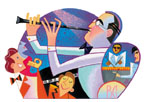Have an opinion about this issue of PAW? Please take a minute to click here and fill out our online survey. It’s an easy way to let the editors know what you like and dislike, and how you think PAW might do better. (All responses will be anonymous.) |
July 6, 2005: Perspective
(Robert de Michiell) |
The
Hot Club
Memories of the King of Swing
By Herbert Shultz ’40
Herbert Shultz ’40, of Kingston, N.Y., has been collecting jazz records and writing about them since the 1930s. His articles have appeared in the Saturday Review and other publications.
In the fall of 1938, during my junior year at college, I became a card-carrying member of the Princeton Hot Club. It was a simple process. My classmate Larry Heyl ’40 and I got together and declared the club organized. We elected officers. By the flip of a coin I became president and Larry secretary-treasurer. We then moved to the meeting’s raison d’être, electing Benny Goodman honorary president by unanimous vote (2—0), after which we adjourned.
My club membership card floated back into my life recently as I was sorting through a box of Princetoniana in the attic. Like Proust’s madeleine, the card evoked memories of those undergraduate years at the height of the big band era when Goodman held the title “King of Swing” — and of an unforgettable November evening when Larry and I were Goodman’s personal guests at his opening night at the Empire Room in New York’s Waldorf-Astoria Hotel.
This was the time when a new kind of music — jazz — was being seen worldwide as a native American art form. For those of us who collected 78-rpm “hot” records and played them on our portable wind-up Victrolas in our dorm rooms, jazz reflected something else: a time full of excitement and discovery. Larry’s collection, and mine, consisted largely of the early recordings of Louis Armstrong, Jelly Roll Morton, Duke Ellington, Fletcher Henderson, and the great blues singer Bessie Smith (our first love). But we also kept current with the latest releases of the top big bands: Count Basie, Tommy Dorsey, and Benny Goodman.
Goodman was at the height of his immense popularity, with a Victor recording contract, and was featured Thursday evenings on a popular coast-to-coast broadcast, the Camel Caravan. Camel’s ad agency came up with the idea of announcing week after week that Goodman had been elected “honorary president” of college hot jazz clubs all across the country, and wanted Princeton to lead off. That’s where Larry and I came in.
The Camel people contacted us through the Commodore Music Shop on 42nd Street in New York, a mecca for jazz record collectors at that time. Run by Milt Gabler and his brother-in-law Jack Crystal (father of Billy Crystal), it produced superb records under the Commodore name and re-pressed classic early 78 rpm’s on its UHCA (United Hot Clubs of America) label. Larry and I had spent many hours in the shop, talking with the owners and visiting with jazz musicians who regularly frequented the store. So when Camel asked Gabler about jazz collectors at Princeton, he gave them our names. Soon afterward I had a call from the ad agency and the club was born.
On the Camel Caravan program one month later, the Princeton Hot Club had a fleeting moment of national radio fame. Following the familiar Goodman opening theme, “Let’s Dance,” came this: “The makers of Camel cigarettes are proud to announce that Benny Goodman has just been elected honorary president of the Princeton University Hot Club. ... In appreciation, Benny dedicates his first number tonight to members of the club.” Then the band swung into one of its familiar hot arrangements. Larry and I — still the only two club members — listened and grinned.
Our promised reward came in about two weeks, with our invitation to be Goodman’s guests at opening night at the Waldorf, where the band had been booked for a month starting in November. We took a train to New York on the big night and were ushered to Goodman’s table, next to the bandstand. We settled down for a long evening of unaccustomed VIP treatment. Helen Ward, the petite, dark-haired vocalist who had sung on many of Goodman’s top-selling records but had left the band to get married, was another guest. Goodman joined us between sets, giving me a golden opportunity to pump him about his first records, made under various labels in Chicago 10 years earlier. The band’s top soloists — Harry James, Bud Freeman, Lionel Hampton, and Jess Stacey — were in top form. Larry, a special fan of Stacey’s piano, ducked under the concert grand to catch the full effect of the chording during the band’s swing numbers. How lucky can a couple of young Princeton jazz buffs get?
After that evening, the Princeton Hot Club expanded its membership from two to a handful of jazz aficionados in the Class of 1940. We held our meetings on Sunday afternoons, gathering in a dorm room to listen to records from our collections. We spent a good part of each meeting trying to identify the great jazz soloists by ear, as there was little written information about the early classic recordings. We played the latest releases of Goodman, Dorsey, Basie, and Ellington, who was moving jazz in uncharted new directions. In 1940, when our class graduated, the Princeton Hot Club quietly expired. It had a short life, but a happy one.
Larry Heyl and I haven’t seen each other in years. But we still
own and treasure some of our old 78s, and we occasionally speak by phone
about those years when we shared the excitement of enjoying a great new
kind of music — and about that memorable night at the Waldorf when
we were guests of the honorary president of the Princeton Hot Club, Benny
Goodman. Life seldom gets better than that. ![]()


